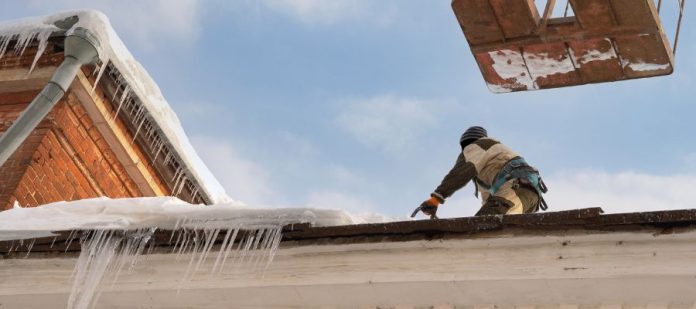When winter comes and snow falls, ice can build up on roofs, melting and refreezing as temperatures rise and drop throughout the day. The frozen concoction that forms is an ice dam that can cause water to pool and sit on your roof, seeping into the cracks of your home. Not only can this water cause roof leaks, but it can also seep into the wooden frame of your roof, freezing, expanding, and cracking the material. Removing these dams can be expensive; repairing any subsequent damages is even more so. To help save your wallet and your home, let’s look at how to prevent ice dams from forming on your roof.
Keep Your Gutters Clean and Clear
Your gutters and downspouts are critical in allowing water to flow off your roof and away from your home. Before winter comes, make sure these critical components are in good shape and aren’t blocked by any debris. Throughout the winter, especially after snowstorms, you should also make sure they’re not blocked by snow or icicles. Any blockages will cause water to back up and freeze over, meaning snow won’t have anywhere to go as it melts during the day.
Use Roof Rakes
Doing roof work on your own is dangerous and generally not recommended, but roof rakes allow you to access and clean your roof from the safety of the ground. After a snowstorm, you can use your roof rake to remove excess snow. The goal here is to keep the amount of snow on your roof to a minimum. Not only does this help prevent ice dams from forming, but it also lowers the load on your roof, preventing possible failure.
Insulate and Ventilate Your Attic
The best way to prevent ice dams from forming on your roof starts with your attic. Attic insulation is vital to the stability of your roof and is a critical part of preventing ice dams from forming on your rooftop altogether. Without insulation, your attic isn’t heated evenly, which causes parts of the roof to become warmer than others. When this happens, parts of the ice dam melt while others stay frozen, causing water to pool in particular areas, resulting in roof leaks and water damage. Attic insulation keeps your roof at an even temperature, so this doesn’t occur.
Ventilating your attic is just as important as insulation. You want your attic to stay cool in winter so the snow melts evenly. Increasing your roof’s ventilation allows warm air to flush out while cold air comes in. Soffit vents allow air to travel underneath your eaves to keep the roof at a consistent temperature. It also helps keeps the area dry and free of mold, which can help minimize damage if an ice dam does cause a leak. Ultimately, the more even your attic temperature is, the less likely an ice dam will form.






















